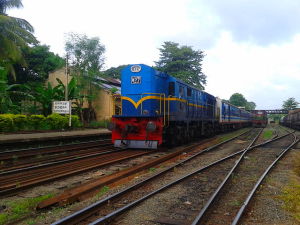A Vestige from the Past Resurrected: Sri Lankan Northern Railway
 Sri Lanka – After thirty years of inactivity, the Northern Railway line will resume carrying traffic between Colombo and Jaffna, resurrected by aid and financial assistance from India. The Northern Railway was a key link between Northern and Southern Sri Lanka, a island nation that had been torn by terrorist separatist, the Tamil Tigers, in the last thirty years.
Sri Lanka – After thirty years of inactivity, the Northern Railway line will resume carrying traffic between Colombo and Jaffna, resurrected by aid and financial assistance from India. The Northern Railway was a key link between Northern and Southern Sri Lanka, a island nation that had been torn by terrorist separatist, the Tamil Tigers, in the last thirty years.
The Northern Railway was a target for the Tamil Tigers, who wish to establish a separate, Tamil ethnic country in Northern Sri Lanka. The Railway first suffered decades ago when the Tamil Tigers tore apart the farthest most northern stretch of the railway and used the rail tracks to build underground bunkers. The Railway was finally shutdown three decades ago due to a bombing by the Tigers in Kokavil on January 18th, 1985, killing 34 people and essentially destroying all north-south rail transport.
With the ending of the civil war in May 2009, the railway has slowly began inching northward and has finally resurrected fully to provide services between Jaffna and Colombo. The Railway’s resurrection is only possible due to substantial investment by the India Railway Construction International Ltd. (IRCON), which provided aid from India.
The Railway serves as a powerful symbol of the unity of the country, as rail is the most common mode of land transport in the country, and previously Sri Lanka had lacked a clear land rail between Jaffna, the largest city in the North, and Colombo. With modes of transportation and connection between the previously separatist north and the rest of Sri Lanka reviving, one can expect business and travel between these two formerly disparate regions of the country to become closer politically and socially.
India’s continuing aid in developing and uniting Sri Lanka is indicative of the role India has played in Sri Lanka for centuries, ever since its introduction of Buddhism into Sri Lanka in the third century. Today, a significant amount of development aid and investment into Sri Lanka comes from Indian firms or the Indian government. India also played a substantial role in the Sri Lankan Civil War.
Sri Lanka’s Northern Tamil majority area has the same ethnic group, the Tamils, as India’s populous Tamil Nadu province. Accusations during the 1970’s and 80’s have been floated that the state governments in India’s south had provided substantial aid to the Tamil Tigers and other Tamil separatist groups. India, in efforts to curb growing unrest in its own Tamil population at the violence and the flood of refugees, in 1987 intervened in the Sri Lankan Civil War, setting in motion continuing Indian involvement to stop the violence of the war. Eventually, the Tamil separatist groups were cowed and settled a peace agreement with the aid and troops of the Indian government.
India has become, with the settlement of the Sri Lankan Civil War, among the largest trade partners with Sri Lanka, especially with the passage of free trade agreements between the two companies. With the Indian government and companies planning to establish hospitals, railways, and other essential infrastructure in recent years, one can only expect ties and business between the two countries to strengthen in years to come. In addition, the continuing ties between northern and southern Sri Lanka and the establishment of the Northern Railway are signs of stability to come.
The Northern Railway represents a return to normalcy and peace after thirty years of ethnic civil war.
